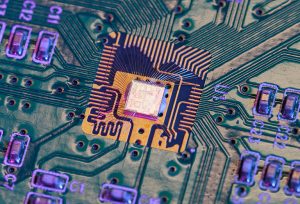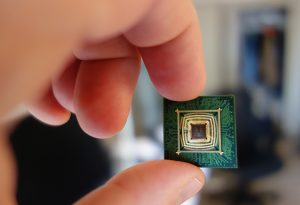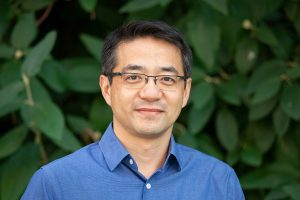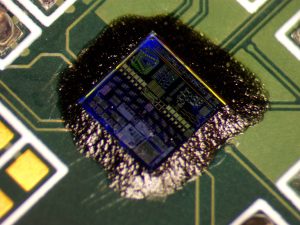By Wayne Gillam | UW ECE News

A recently designed microchip from the lab of UW ECE Professor Chris Rudell (in gold, mounted to the green circuit board shown above). This chip is a 2.4 GHz full-duplex transceiver, which employs multiple self-interference cancellation techniques to improve signal fidelity and efficiently use limited bandwidth. The chip has a broad range of applications, including use in satellite communications and radar; shipping, aviation, and space industries; and 5G technologies. Photo by Ryan Hoover / UW ECE
Semiconductor devices, such as integrated circuits or microchips, have become a necessity for modern life. Long considered to be the brains of modern electronics, these tiny chips can be found in almost every electronic device in use today. And their impact is vast, supporting every sector of the U.S. economy, as well as national security. Currently, all major U.S. defense systems and platforms rely on microchips for their performance, and in many cases, simply to operate.
It is with these things in mind that the White House passed into law the CHIPS and Science Act of 2022, which is making historic investments in semiconductor research, workforce development and manufacturing. The CHIPS Act aims to bolster supply chains and reassert the U.S. as a global leader in semiconductor manufacturing. Over the next couple of years, billions of dollars will be pouring into this effort, and faculty from universities and colleges around the country will be competing for research and development funding, including many from UW ECE.
“At UW ECE, we have top-notch faculty researchers, strong industry partnerships, and we recently redesigned our undergraduate curriculum to offer academic pathways for students interested in pursuing studies and careers related to the semiconductor industry,” said UW ECE and Physics Professor Mo Li, who is the Department’s associate chair for research. “We also have hired two new faculty members whose research is in chip design, and we plan to add more faculty with semiconductor expertise in the near future.”

The Bespoke Silicon Group (BSG) Ten chip from the lab of UW ECE and Allen School Professor Michael Taylor.
Li, as well as other UW ECE faculty, such as Professor Michael Taylor, who holds a joint appointment in the Paul G. Allen School of Computer Science & Engineering, have contributed to and partnered on several proposals and initiatives that would help to bring CHIPS Act funding into semiconductor research and workforce development at UW ECE. The Department has also spent a significant amount of money over the last two years to upgrade and refurbish its electronics teaching labs.
“Semiconductor design and development is at the heart of electrical and computer engineering, so our Department is well-positioned to leverage funding and support stemming from the CHIPS and Science Act.” said UW ECE Professor and Chair Eric Klavins. “I’m especially excited about the opportunities this will provide for our students and faculty, as well as how it will strengthen our existing collaborations and create new industry, government and community partnerships.”
UPWARDS for the Future

UW ECE and Physics Professor Mo Li is the Department’s associate chair for research and a principal investigator in UPWARDS for the Future. UPWARDS is aimed at providing advanced training and research opportunities that will grow the nation’s semiconductor workforce. It will also help the U.S. and Japan build more of the microchips that both nations need. Photo by Ryan Hoover | UW ECE
One of those new partnerships is the U.S.-Japan University Partnership for Workforce Advancement and Research & Development in Semiconductors (UPWARDS) for the Future, which begins September 1, 2023. UPWARDS brings together six U.S. universities and five Japanese universities with Micron Technology to provide advanced training and research opportunities that will grow the semiconductor workforce and help the U.S. and Japan build more of the microchips that both nations need. A total of $30 million in funding is available for this collaboration, including a $10 million grant provided by the National Science Foundation’s new Directorate for Technology, Innovation and Partnerships, which was authorized by the CHIPS Act. Matching funds were provided by Micron and Tokyo Electron. Li is a principal investigator for the grant, alongside David Bergsman, who is an assistant professor in the chemical engineering department.
“Our nation’s success in advanced technologies depends on having a strong workforce,” said Washington Senator Maria Cantwell in a recent press release about UPWARDS, which she had a hand in creating. “This NSF award, led by the University of Washington, will help establish the Pacific Northwest as a leader in training the more than 90,000 students, faculty, and skilled professionals needed to build the most advanced chips right here in the United States. If we want to lead the world tomorrow, we must invest in worker training today.”
Looking ahead

The EOS24 Chip is advanced silicon photonic technology developed in the lab of UW ECE Assistant Professor Sajjad Moazeni. It contains high-speed optical transmitters and is flip-chip bonded onto a high density printed circuit board. This chip has applications in high-speed modulators, optical communication and computing.
This fall, UW ECE is looking forward to welcoming two new assistant professors, Ang Li and Hossein Naghavi, who produce research important to semiconductor development. Li has expertise in computer architecture, digital very large-scale integrated (VLSI) design, and reconfigurable integrated systems, and Naghavi is an expert in integrated terahertz electronics.
Overall, UW ECE is experiencing rapid growth, partly in response to the CHIPS Act. The Department plans to add five new faculty members next year, including one position at the associate professor level that will be focused on semiconductor design. The number of undergraduate degrees produced annually at UW ECE is also projected to scale up significantly in the next two to three years. This is mostly because of the increasing need for more electrical and computer engineers, but it is also driven by market demand for skilled semiconductor engineers, which is being stimulated by the CHIPS Act.
The UW College of Engineering is designing a plan for an interdepartmental, multidisciplinary curriculum focused on semiconductor technology. This curriculum would provide university-wide, multiple pathways for students and could include offering new undergraduate minors and certificate programs. Professor Mo Li noted the UW’s stature as a flagship university for Washington state as well as its proximity to and existing partnerships with Microsoft, Amazon, Boeing, Micron, and Intel — all key players in designing, developing, manufacturing, and distributing microchips.
“Our industry partners tell us what kind of skills they need for particular types of jobs in the semiconductor industry,” Li said. “We want the curriculum we develop to match industry needs. So, then we will know that if a student gets this certificate or that minor, they will have the complete skill set for the job they are looking for. That’s the benefit for both sides, for our industry partners, future employers, and most importantly, for our students.”
Learn more about the CHIPS and Science Act on the White House website, and about the UPWARDS partnership in Senator Maria Cantwell’s recent press release, as well as in the UW student newspaper, The Daily. Contact Professor Mo Li for more information about how this historic legislation is impacting UW ECE.

